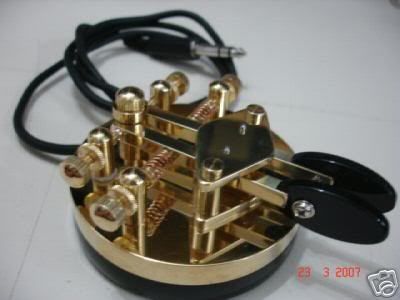NEW KEY ARRIVES (FINALLY). After nearly 8 weeks, a much-awaited box was in my mailbox today — an iambic cw paddle I had won in an auction from a guy in Brazil.
Brazil?? Iambic? What gives?
Yeah, I suffered a weak moment and took what appeared to be a manageable risk — I went after a cw key (not a bug!) being sold by a guy in Brazil. His feedback was pretty good, but his written English was lacking a bit. Even at that, you could still understand his meaning, which is more than I can say for current music viddeos.

The seller has been selling these unique looking keys on eBay for quite some time. Not constantly, but he'll have a run of them, selling two or three a week and then he disappears for a month.
I can't say exactly why, but I was instantly attracted to the keys he sells. They're round, about 3-1/2 inches in diameter, and come with a brass or chrome finish.
The base is in two halves. The top half is brass, and is the mounting point for all the key's hardware. The bottom half of the base is plastic and hollow, allowing for the wiring and what-not to hook up and be hidden from view. The cable exits thru a notch in the plastic base toward the rear of the key. The plastic base is thick and has a non-skid soft vinyl pad attached to the bottom surface.
The plastic base is attached to the upper half of the base with one large screw in the middle. Again, I don't know the attraction for the key, but I've wanted one since I saw the first one.
CONSTRUCTION. The key isn't a Begali, let's get that clear. The seller on eBay usually has a Buy It Now of $70 — not a bad price for a decent iambic paddle (considering the cost of a Bencher, Kent or Vibroplex iambic key).
The keying levers each have one pivot pin that is a press fit in the lever. The pivot pins are held in place by the two brass plates; one is on the key base, the second is elevated by two cylindrical supports. There's no bushings on the pivot pins, the steel pins ride in the brass, but there's not much slop.It's not adjustable, it is what it is.
The height of each keying lever is adjustable; each pivot shaft rides in a bearing cup that appears to have been crafted from an hex head set screw that's been drilled to accept the pivot shaft. The hex head set screws are locked in place by lock nuts. To adjust the height, you loosen the lock nut and adjust the hex heat “bearing” up or down. It's not very high tech, but it appears to work fairly well.
The tension on each lever is independently adjustable. Unlike some of the Ukranian keys I've tried, these springs allow for a wide adjustment range to suit the operator's preferred feel.
I was a little surprised at how small a key the Brazilian key is. The diameter sounds large, but the paddles and assorted parts aren't huge. The paddles are some of the smallest I've used on an iambic key.
The contact spacing can be adjusted easily for the desired travel. The adjustments don't wander, and the fine threads on the adjustments allow for fine tuning. You can set the contact spacing very, very close and the key seems to work fine this way, no runs, no extra dits, no errors (other than those of the operator).
The key in the auction I won was not a new one, but was used. The brass had dulled down considerably from the image of the key you see here. The guy sells the chrome version for the same price — something I wouldn't do, i would charge about $20 extra. BTW, I disassembled the key and polished it and reassembled it. It's still a “different” key that works pretty well. All polished up, it looks great on the operating desk.
Is the key worth $70 brand new (plus shipping from Brazil)? Considering the competition in the price range, I would have to vote “yes.” The key is attractive and not the garden-variety key that's at everyone's shack. It stays put on the desk, and it's attractive.
SPEED-X UPDATE. I may have tried too hard to have the ultimate wrinkle paint job on the base of my Speed-X key. I had it nearly perfect and made the mistake of trying to make it just “a little better.”
I may have “little better'ed” it to death … Once the kids are back to school I'll revisit the key and see if I need to sand it all down and start again, or salvage the paint that's on it. This wrinkle paint stuff is some kinda chemical voodoo anyway. It doesn't wrinkle fully for roughly 30 minutes, and only then can you determine if your coating is uniform. If not, then you spray it again, hoping to fill in the missing wrinkle area — but again, you can't tell for another 30 minutes. Just plain ol' flat black is looking better all the time.
